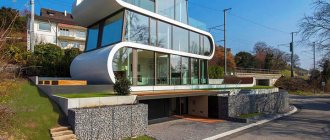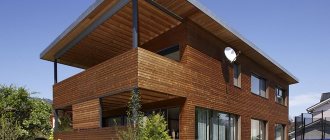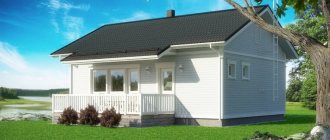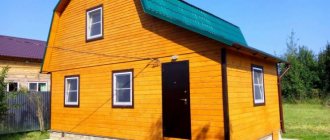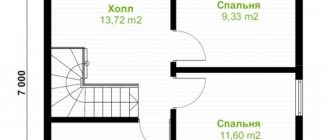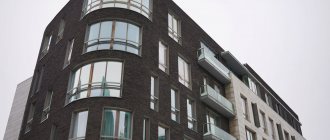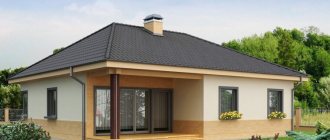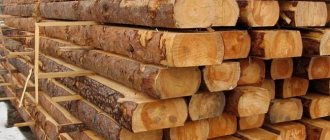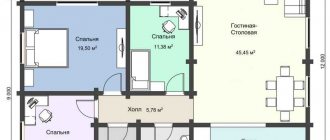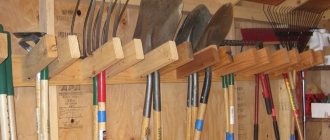Beautiful houses today can be found in any large suburban village. They are famous for their incredibly elegant designer façade. In addition to the external design, the internal space in such dwellings is arranged according to a similar principle. But for this it is important to take into account several nuances of the layout and rules for creating a spectacular exterior.
A beautiful house with an unusual exterior design Source wallpaperscraft.ru
Wooden house with an unusual layout Source crimea-les.ru
House of unusual shape with two floors Source in.pinterest.com
One-story cottages: complete fusion with the landscape
One-story projects are a traditional solution for areas with a lot of greenery. Low cottages look harmonious both in open space and in forest surroundings.
Laconic design in beige tones
Spacious villa for a large family
Stylish country house in a pine forest
Cozy red brick cottage
See also: Beautiful brick cottages: 60 photo ideas
Small private houses: what size to choose?
The size of a potential small house project is an important selection criterion according to which a person is looking for the best housing option. In the collection of small houses you can find buildings with a usable area of up to 150 m². People are also interested in buildings up to 110 m² and plans up to 80 m². Building a very small house, for example 60 m², can also be an ideal alternative to buying a medium-sized apartment, which is why many people choose this solution. Your own home is first and foremost the improved comfort of family life, but also your own garden, personal garage or carport.
Two-story cottages: saving usable space
The second floor in a country cottage provides an excellent opportunity to enjoy picturesque views and at the same time reduce construction costs. Such projects are designed for permanent residence of a large family.
Tall bay window with panoramic windows
Country cottage in modern style
Laconic design with stylish finishing
Luxurious mansion with a basement floor
High tech
The high-tech style in architecture is characterized by strict forms, an abundance of glass and metal surfaces and details. The direction is characterized by strict forms, a maximum of glass and metal. Communications are part of the interior. There are no load-bearing walls or screens inside the house. Large windows of geometric shapes resemble shop windows. High-tech buildings have flat roofs.
The goal is a highly functional home. In the construction and improvement of housing, new technologies are used and certain materials are used: glass, metal, plastic, concrete. The design is simple and concise without decorative elements.
Artificial lighting sources: spotlights, LED strips complement daylight. Mirror and glass surfaces have a reflective effect, making the house even brighter.
Project
A two-story cottage made of aerated concrete in a high-tech style with a total area of 128 m2 (11×12 m).
The main features of the style embodied during construction: clear geometric lines, simple finishing of external surfaces with plaster and fiber cement siding.
The foundation is laid from monolithic reinforced concrete. The main detail of the facade is the terrace on the second level. Fused roofing was chosen as the material for the roof. Panoramic windows provide daylight penetration inside and decorate the walls of the cottage.
On the ground floor there is a utility block (boiler room, pantry, laundry room) and a kitchen-living room.
The remaining free space can be used to organize a work office or a mini-gym.
On the second floor there are 2 bedrooms and a large terrace for outdoor relaxation. The terrace can be accessed from the second floor or via stairs from the street.
The house is designed for a family of three. The building, built in a high-tech architectural style, will be in harmony with both the urban and natural landscape.
Cottages with a garage: there's room for everything
A place for a car in a country house is as urgent a need as a comfortable terrace for relaxation. Modern cottage designs provide from one to three parking zones, while garages can be built-in or free-standing.
Hospitable country house with convenient access
Detached garage with three spaces
Spacious garage for two cars
Traditional garage entrance
Advantages of two-story houses
Building a comfortable two-story house today is not as expensive as most consumers believe. Of course, such a choice will not cost less than a one-story building, but it is worth it. You can choose a ready-made project for a 2-floor house with a layout or create an individual one. Professional architects and designers will be happy to help you make your dreams of a two-story country house come true and offer relevant solutions that suit your budget.
Plan of a modern two-story house Source bawim.desany.ru.net
The main advantages of a country two-story house:
- Rational use of land. If you have received a very small plot of land within the city or beyond, naturally, you will want to equip it with maximum benefit so that every square meter can work. Why take up valuable real estate with a squat, one-story house? It is better to distribute the same premises on two floors, and equip a garden and a recreation area with a gazebo and barbecue on the site.
- High level of comfort. Two floors make it possible to very clearly separate the rooms in which people sleep and relax from the so-called common rooms and work rooms. Traditionally, bedrooms and offices are located on the second floor, and the living room, dining room, kitchen, and playroom are on the first floor. Thus, several generations of families with different daily routines and interests can live in one house with all the amenities.
Plan of a spacious two-story house Source derevyannyydom.com
- Reliable and simple design. Some people decide to save money on the design of a two-story house and look for an alternative option with an attic. In fact, it is not cheaper at all, and sometimes even more expensive. After all, correctly designing and building structures with a sloping roof, correctly connecting all communications to the attic, insulating it, making it comfortable and safe for living is actually much more troublesome than doing all the same work when designing a house with a full two floors. If you need additional useful meters of living space, it makes sense to immediately choose a two-story house rather than a building with an attic.
So, beautiful two-story houses are the ideal balance between usable space and the costs of creating a project and construction, aesthetics and comfort, the necessary personal space for each family member, but without frills. It is quite possible to ensure such characteristics - if the project is developed by specialists who are well aware of all the intricacies of the construction process.
Plan of a large two-story house with an open terrace Source cottages.nsk.ru
Luxury cottages with swimming pool: country house with all amenities
A country house with a swimming pool is not only beautiful, but also practical. There is a place for a pond even in a small area, the main thing is to properly zone the space.
Ideal for a summer holiday
Laconic solution with a large swimming pool
Stylish swimming pool with relaxation area
Economical option - small swimming pool-jacuzzi
What to consider when planning a house: the main characteristics of a beautiful structure
The beauty of the outside of the house depends on compliance with many principles:
- The uniqueness of the project. The appearance must be individual. The more interesting the facade, the better it will be to stand out from the background of standard construction projects: classic houses.
- Despite the attractive and rich appearance, the interior space should have enough natural light. Therefore, the windows in such houses are made of massive frames with large glass.
- The shape of the building on all sides must correspond to a single stylistic concept. It is advisable to decorate everything with building materials from one batch. Otherwise, differences in shades will be visible.
- Raw materials must be of good quality. It is important that it can be used for as long as possible. Preparatory work, planning and general construction are also important to carry out correctly.
A beautiful house, like any other residential structure, requires care when choosing a site and analyzing suitable building materials. After all, if you ignore this factor, soon all the external beauty of the building may collapse. This mainly happens when the properties of the soil and the depth of groundwater are not taken into account.
A beautiful mansion for a large family with a tiled roof Source 1zoom.ru
Multifunctional residential cottage with a swimming pool Source ustaliy.ru Two-story residential building with large gables Source in.pinterest.com
Cottages with an attic: an elegant solution
Attics act as a stylish decoration of the facade and provide additional living space. Depending on the project, this can be a small cozy room under the roof or an almost full second floor.
Bright combination of stone and glass
Small attic for one bedroom
Carved fairy tale in a pine forest
Bright accents on a gray background
Classic style
Classic style is always relevant. During the construction and decoration of a private mansion, only natural expensive materials are used: stone, marble, wood. The color scheme of the facade and interior is calm and noble. The decoration includes elements of stucco and artistic forging. But the design should not be overloaded.
Project
A one-story private house in a classic style with a hipped roof. The total area of the building is 247.3 m2 (14.5 m × 10.5 m).
A small one-story mansion is suitable for a family of 3-4 people. The cottage space includes a living room combined with a kitchen, a guest bathroom, a home laundry room and a utility room for storing household items and equipment. The living room-kitchen is separated from the other rooms by an opening.
On the second half of the mansion there are bedrooms (4 rooms) and a bathroom combined with a toilet. The cottage also has a basement and attic space. The house has two entrances. The decor of both porches are rounded columns.
Cottages with a terrace: comfortable stay
A country house is unthinkable without a terrace - spacious or miniature, covered with vines or open to all the winds, sunny or shady. Pay special attention to glazed options - you can relax on such terraces even in the cold season.
Cozy glass terrace
Wooden terrace in modern style
Compact country house made of rounded logs
Grape coolness for hot summer days
House on a small and narrow plot
Today it is easy to find interesting house designs for a small plot of land, which, despite all the restrictions, will allow you to build comfortable and functional apartments. Consider small houses with attics for narrow lots, two-story buildings, and practical plans for small one-story buildings on limited space. When choosing such a house, special attention should be paid to the possibility of correct placement of the building in relation to the cardinal directions in order to effectively use solar energy.
Tiny houses are a full spectrum of stylistically diverse buildings. Here you will find interesting projects of small traditional buildings, the character of which is emphasized by architectural details, such as: columns, arcades, projections, terraces, decorative window openings. People who appreciate modern architecture will find a wide selection of “modern small houses” that follow the current minimalist trend with a unique flat roof. The choice is yours!
Cottages with a bay window: stylish architecture of a country house
The traditional shape for a bay window is a polygon. Facades with semicircular projections look more advantageous, but such projects are more difficult to implement.
Stylish bay window for the living room
Cozy solution for the kitchen
Semicircular bay window on two floors
Hanging bay window in French style
Original roof of the bay window area
Video description
Watch an example of the layout and design of a two-story house in the video:
Optimal dimensions of a two-story house
What size an ideal two-story house should be is a controversial question. For a family of four who have lived their entire lives in a one-room apartment, a house with an area of 80 square meters. m. will seem like a mansion. And some will have to cram into 180 square meters. m. And yet you can find a “golden mean” - the optimal area for a family of four to six people to live - 140–160 sq. m. m. In such a house you can comfortably equip a large living room, kitchen, two bathrooms and three bedrooms - excluding balconies and auxiliary utility rooms.
An example of the layout of a two-story house with an area of 223 m² Source pinterest.com
First floor layout
The photo below shows some of the most successful and interesting ground floor projects for a medium-sized residential building. There is a garage, utility room, stairs, guest bathroom. The living area is a living room-studio with areas for cooking and eating. From the living room there is access to the terrace.
An example of the layout of the first floor of a two-story house Source tcst.ru
The photo below shows a classic layout; on the ground floor there is a kitchen and living room, utility rooms and a garage for one car, and one guest bedroom. From the living room there is access to the veranda.
Another example of the layout of the first floor of a small two-story house Source dom4m.kz
You can plan the arrangement of rooms on the ground floor in any way you like, the main thing is that your ideas do not contradict the safety rules for designing houses.
Cottages with ondulin roofing: the optimal roof solution
Roofing made of ondulin and onduvilla goes well with most modern building materials. The photo shows projects of country houses of different sizes and stylistic orientations.
Norman style house
Compact idea for a country house
Rich green and some brick
Onduvilla - an exact imitation of natural tiles
Ondulin is an excellent solution for a wooden cottage
Ondulin and rounded logs are always a good combination
Minimalism
A house in the minimalist style is distinguished by the absence of decorative details both outside and inside. Living space is used as efficiently as possible. Each item performs its own function.
But the building does not look ascetic. The modern house, built and decorated in a minimalist style, is spacious and comfortable. Thanks to the presence of only the necessary pieces of furniture and household items, it is easier to maintain order in the house.
From the outside, a minimalist house is distinguished by its simplicity of form. One of the main features of the style is large window openings of rectangular or square shape.
Characteristic features of the architectural style when designing and finishing the facade:
- natural lines;
- presence of sharp corners;
- use of natural building materials (wood, stone).
A popular solution for the facade is a plastered surface in light colors. Stone, ceramics, wood, metal, and concrete are also used for exterior decoration.
Glass inserts in doorways and in the roof are designed to fill the house with natural light.
Project
The area of the object usually does not exceed 200 m2. This footage allows compact and comfortable accommodation for a family of three to four people.
At the design stage, it is important to provide high windows and doors with similar parameters. The roof is designed with cantilever projections. There is an outdoor terrace downstairs. The roof surface can be used for relaxation and sunbathing.
The house consists of two buildings: the main one and the utility building.
Main premises rooms:
- living room + dining area and kitchen;
- bedroom + bathroom and dressing room;
- children's room;
- game room;
- study.
An outbuilding usually contains heating equipment, tools, and gardening tools.
When working on a project, it is important to outline the functional zones into which the space will be divided. Minimalism does not imply the presence of partitions and screens.
Wooden cottages - environmentally friendly and beautiful
Wood is the best choice for a country house. Such facades do not require additional decoration and are harmoniously combined with various roofing coverings: corrugated sheets, ondulin, flexible tiles (onduvilla and analogues).
Country house with two terraces
Spacious wooden mansion
Original carved mansion
In complete harmony with nature
Russian style combined with Finnish technologies
Unusual combinations and massive shapes
See also: Beautiful interiors of cottages: 60 photos inside country houses
Provence
For interior decoration, the French provincial style with warm pastel colors is often chosen. Characteristic features of Provence:
- in the decor there are beams on the ceiling (walls);
- use of natural materials in decoration and furniture;
- panels (made of wood), decorative plaster, etc. are possible;
- antique furniture;
- textiles are plain or with discreet floral patterns.
Color palette: beige, yellow, reddish, blue, bright green tones. Floor vases with fresh or dried flowers will fit perfectly.
Cottages made of timber: minimum finishing, maximum style
Country houses made of glued or profiled timber fit harmoniously into the surrounding landscape - be it a river bank, a pine forest or a sunny meadow. The facades of the cottages do not need finishing; they are beautiful in themselves.
Country house made of timber - an eco-friendly holiday
Light and spacious - wooden cottage with panoramic glazing
Cozy guest houses
House on the lake: stylish and strict
Cottage made of timber: compact and practical
See also: Beautiful cottages: 60 photos inside and outside, design ideas
Why is building small houses so popular today?
According to available data, modern people are most often looking for small two-room apartments. This happens due to financial limitations. Apartments that can provide more comfort to a family actually start from 60 m². In this area, developers often create three small rooms where you can live comfortably and place all the essentials. Unfortunately, an apartment of 60 m² costs a lot of money, especially in large cities. And a square meter in your own home will always be cheaper than a high-rise apartment, so don’t think for long, but choose a project for a future private property to live in from the photos presented.
Maybe you should think about all the advantages and choose a small house? If we already have part of the land, for example, from our parents, then we can easily build a budget residential building on it, especially if you select the right building and finishing materials, decide on the structure of the roof, the number of floors, the presence of a garage and an attic. A small house is an excellent economical option for a small family, couple or single person.
Cottages in a modern style: unusual projects
The facades of cottages in a modern style can be made of natural materials and their analogues. The most beautiful and airy projects are made of concrete and glass; brick looks solid and representative; wood suggests complete unity with the surrounding nature.
Perfect sunset view
Stylish idea made of stone and glass
Classic brick with a modern twist
Unusual white roof
Complete fusion with nature
Chalet
The French chalet style is similar to country style, but has its own unique features: large window openings, a wooden staircase with elements of artistic forging, and a living attic space. In a private house, you can take into account all the features of the architectural direction.
The central part of the living room can be a fireplace trimmed with stone. You can arrange a lounge area around the fireplace: install a large sofa and two armchairs.
The kitchen-studio space will be divided by a wooden bar counter. The kitchen wall is also made from natural materials.
When constructing a house, wood and stone are used. A chalet-style building can be recognized by its gable roof with edges protruding beyond the house.
The walls do not require finishing. Natural wood creates an atmosphere of warmth and comfort. The ceiling is finished with wooden beams. In a small room, the ceiling is plastered in light shades.
The chalet can also be combined with high-tech elements: open communications, modern appliances, metal and glass details.
Project
One-story private brick house in chalet style. The area of the building is 118 m2 (14×12 m). With proper planning and zoning, the space will be enough for a family of 4 people.
Monolithic reinforced concrete can be used to lay the foundation.
The exterior of the house is finished with clinker tiles and natural stone. The roof is covered with metal tiles. These exterior finishing materials form a single ensemble.
Large windows let in maximum daylight. You can enter the house through the main entrance and from the porch. The terrace with a canopy also serves a decorative function.
Walls: configuration, choice of material
In order to reduce the cost of construction, many choose the cheapest materials for building walls. It is worth noting here that you cannot choose cheap and low-quality materials. Analyze all available and affordable options and make a choice in favor of the most optimal one.
In forest areas, the most optimal material in terms of price-quality ratio will be wood. In the steppe zone it is adobe. In places where there is a lot of natural stone, shell limestone is considered the cheapest material.
If all the proposed options are not suitable, you can build a house from aerated concrete with your own hands. When choosing building materials for your home, do not forget to take into account their cost, delivery and installation in the estimate. Also be sure to take into account the speed of laying materials, lightness and simplicity.
Do it yourself: building a cottage (105 photos)
Two craftsmen decided to build a cottage with their own hands. And they offer to look at photographs taken from the first days of construction.
They planned to build such a house. there are 2 guys - me and my brother, 2.4 million money, 4 months. for construction.
sketch design of the 1st floor. There is a plot of 12 acres in Medovka with an old wooden house. We planned for half a year, calculated the estimate and made calculations for the entire structure.
we dig a trench under a strip foundation 40 wide and 80 cm deep. The dimensions of the building are 20.4 m by 10.8 m. The volume of excavated soil is 25 cubic meters. Made it in 4 days. We dug in May with 2 shovels. plus a day for marking and geodesy.
we dig a trench under a strip foundation 40 wide and 80 cm deep. The dimensions of the building are 20.4 m by 10.8 m. The volume of excavated soil is 25 cubic meters. Made it in 4 days. We dug in May with 2 shovels. plus a day for marking and geodesy.
reinforcement diagram. the reinforcement was laid in 2 rows: the bottom one in 3 cores, the top one in 2 vertical rods were placed every 1 meter. Since the house was a 2-story house, the corners were reinforced with piles and the reinforcement was knitted with an overlap. it took 5 kg of knitting wire.
We ordered concrete, grade 150, fraction 5-20. price 3000 per cube with delivery. We called many companies, chose the best one, payment upon delivery.
2 hours of continuous rowing with shovels and concrete in a ditch. The guys were kind and they had extra gutters, which made our work easier. in just one day we took 25 cubic meters. finished at 3 o'clock in the afternoon. They paid 75,000 rubles for concrete. the foundation cost 105,050 rubles. Hired workers will manage without the material: design and estimate 10% of the cost of the material, surveyor 5,000 rubles. earthworks 600 rub. cube concrete with viscous reinforcement 2,000 rub. per cubic meter total: 225,000 rub. Since my brother and I have experience in construction, we are building the entire house ourselves and will only hire transport.
While the concrete was cooling, a grounding loop was immediately laid. triangular trench with sides 3 meters and depth 70 cm. corners 50x50 and 3 m long are driven into the corners, welded together with a strip
we bring bricks. for the plinth you need about 5,300, the rest will go to pipes and poles with the import costing 50,100 rubles, it makes no sense to look somewhere cheaper because we have one plant
While we are delivering bricks, we have ordered a drilling rig. the well came out cheap because the water in the honey pot is very close 20 m. the cost with a filter is exactly 30,000
We also purchased some additional tools. welding machine 190A 7 100 mask 500, submersible vibration pump with hoses 2 000. and polyethylene film 25 m. needed to separate brick from concrete. everything according to science. the current total cost is 189,800
They carried it out for 1.5 days, but realistically in a day. Our sister's husband helped us in this matter. For which I thank him very much. In the morning we ordered a solution of brand 100 1.5 cubic meters
At the same time, we welded the grounding loop and buried it. We quickly built a box for the solution from improvised materials. don’t be lazy, strengthen it adequately so as not to collect all the solution in the area later)))
1 delivery of the solution was unsuccessful. We ordered from private sellers and were very dissatisfied with the quality of the product. with the delivery of 1.5 cubic meters it cost 4,900; they did not complete the entire volume planned for the day because I had to throw out about 0.5 cubic meters.
results of 2 days of laying. 5,300 can actually be laid by two people in 3 days. if you know how to do it, if the material is good, and the weather doesn’t let you down. You will need about 4.5 cubic meters of solution. We plan to reach the zero level the day after tomorrow and start laying communications
the zero cycle is completed. we buy a primer or bitumen mastic and go through all the internal walls with it. (hydraulic shutoff) now we proceed to the sewerage system
It took 6,300 for all the pipes; with proper calculation, assembling them is not difficult. To connect PVC pipes, we buy a special lubricant.
the slope must be at least 3 mm per 1 meter. The landscape of our site helped us with this and we didn’t have to bury them too much. All pipes are laid on a sand cushion (bed), we placed the necks of the pipes about 6 cm from the floor
We dig a hole for sewer rings. we decided to take 1.5 m in diameter. We will bury 3 rings. Now we order the soil and fill it up 15 cm short of the top. We leave that much for the sand cushion, water supply and rough screed.
So, let's move on to the drainage hole. Having used the terrain, there is no need to give the pipes more slope. We do it conscientiously so that we never call the sewer trucks, we dig a big hole. we bury 3 rings with a diameter of 1.5 meters and a height of 1 meter. with the cover, delivery and hatch it cost 14,200.
dug for 2 days. the soil was disgusting, almost the entire depth was loam. you need to dig 3.30 m deep. In photo 2. 60 the hellish hole came out.
There are 2 ways to dig drain holes by hand. 1. when you plumb the entire depth of the hole and then install the rings. there is a minus. Not all rings correspond to their sizes, which is what happened with us. the dispatcher (who neither….I don’t know) gave us the wrong dimensions, which added 2.5 hours of work to us. the point is this. They dug for an OUTSIDE diameter of 1.5 meters, but in fact the diameter came out to 1.7 meters. and this means that the rings will not fit there. Method 2 is used here, when you dig 1 meter. mount 1 ring on top of it, place it in thirds, lower into the inside of the hole and begin to dig them up. under their own weight they will go down. The advantage is that you do not remove excess soil. The downside is that it’s wildly inconvenient and slow and requires maximum labor. Plus, you will then have to install the hatch cover manually or call in small mechanization, for which you will have to pay. so 1 is optimal
Please note that we mounted the 2nd ring on bricks. This is such a clever move to increase the efficiency of the drainage pit so that sewage is absorbed into the soil not only through the bottom. some people also make pits (holes in the lower ring) to increase the efficiency of the pit, but there is a minus in this method. this weakens the ring itself. because we live in Russia where almost everything is done on the *****. reliability is the most important thing. There were cases where the rings simply broke in the pit. this indicates that they were poorly reinforced at the factory, and it is almost impossible to check this on site
the rings were installed. Let's start leveling the soil. it will take a lot of it. In addition to the fact that we removed 25 cubic meters from the foundation, 5 cubic meters from the drainage pit and a cube from the ground loop, we also need 45 cubic meters of soil. it weighs about 50 tons under a shovel. 5 trucks of soil cost us 14,300 + forgot to add 3 deliveries of mortar for 4,800 each, in total with rings, soil and mortar it came out to 43,400, in total our consumption at the moment is 241,400
the drainage hole is completed. In order for all the rings to work fully, the drain pipe must go up the ring, so the rings had to be planted another 0.5 m into the ground. We’ll install the pipe later, because equipment will be walking around the site and could crush the pipe.
We delivered polystyrene foam and a profile for the screed. according to the receipts it came out: 8,400 polystyrene foam and 1,800 profile and 420 metal scissors. total 10 720 +5 00 for extra. sand and transport. our expenses are only 257,200
We delivered polystyrene foam and a profile for the screed. according to the receipts it came out: 8,400 polystyrene foam and 1,800 profile and 420 metal scissors. total 10 720 +5 00 for extra. sand and transport. our expenses are only 257,200 and this mighty green mop. homemade device. but very useful. it will be useful to stretch the tie. I'll show you how later. insulate floors: our method is the simplest. no ventilation or additional insulation options are required. minus one. An unreal amount of soil was used, about 110 tons!!!!!!Our site does not allow the use of machinery, so we carried everything out manually. it's unrealistically difficult. Method 2. strengthen the foundation and install slabs. reliably, there will be no problems with all methods of insulation, but there is a minus of money; throw about 100 thousand more for such an area. 3 way. light overlap. take a larger beam or rafter and overlap it. costs minimal money. You don’t need so much soil, but it’s not reliable, ventilation and bioprotection are needed very seriously. For such areas it is not suitable. There is a technology for pouring concrete onto a sheet profile, but almost no one uses it. Most likely they just haven’t mastered it yet. but I’ll try to use this technology when I cast a balcony slab. The interesting thing is that with the help of profile ribs, an excellent design is obtained with minimal material costs, minimal weight and high load-bearing capacity.
we draw water around the house. all the pipes (cold water, hot water, heating) the guys were competent and gave us a discount, the pipes were bought from German and Czech manufacturers. I don’t remember from memory, I’ll tell you exactly later. it turned out exactly 20,000 + 2,700 welding feed cold (according to the advice) they made 32 diameters. DHW supply and return 25 diameter. It is not necessary to make a return line, but take into account the length of the pipes from the boiler. she will be needed. otherwise, when you open the hot water tap, you will have to wait a long time for it to flow. and I will always have it at the tap.
Serve cold (according to advice) made 32 diameters. DHW supply and return 25 diameter. It is not necessary to make a return line, but take into account the length of the pipes from the boiler. she will be needed. otherwise, when you open the hot water tap, you will have to wait a long time for it to flow. and I will always have it at the tap.
unsolder the heating. stripping pipe. what does it mean. a pipe reinforced with a layer of metal that needs to be peeled off for soldering. For this there is such a gadget that Maxim has in his hands.
the water was boiled. We plan to finish heating tomorrow. Tomorrow the material for the walls will finally arrive. We think we'll fill the screed on Tuesday and start working on the box.
install a profile. it will serve as a beacon for us when we pour the screed. The solution for the profile needs to be more abrupt.
let's continue. This is what the water intake point on the 1st floor in the boiler room looks like. I had to tinker with the heating. We will hide all heating pipes in the walls. so that later there are no problems with connecting the batteries, sign all the pipes and where they come from
We import gossilicate for the box. According to the estimate, 145 cubic meters are needed. this is 4 trucks. Because the facade will be covered with textured plaster, you need to take a good gas. found the optimal supplier at an affordable price. I’ll tell you more: the weather was disgusting. but there is nothing to do. Liskinsky bought silicate. there are a lot of positive reviews about it, especially since there are only 2 manufacturers of gas silicate, which are suitable in quality for laying on glue (but more on that later.) LGS is produced on German Wehrhahn equipment and the quality is excellent. For comparison: you can buy locally made shit, it will cost 2,400 per cubic meter. but you will lose on plaster on both sides, mortar and thermal conductivity. There is another one - also a good gas car, but it is expensive. 3,300 without delivery. The delivery of the LGS cost us 3,050 + the manipulator 1,500 per hour. We unloaded it in 3 hours with just two of us. the total cube to the object was 3180. The truck brought 38 88 cubes. in pallets - 27 pieces. The manipulator turned out to be very good, which is not unimportant.
pour the screed. We order sand concrete M150, we ordered it there, according to calculations, 10 cubic meters should be enough. This is where that unsightly green mop comes in handy. I believe this is the best tool. tested by experience. advice. Strengthen the profile better with the solution, otherwise it will be knocked down by the jet or you will knock it down with your foot in your haste. and without guides it is difficult to fill a more or less normal screed, especially in such areas. and stock up on boots)))
started at 10 am, at 4 pm the screed is ready, deviations from the horizon are within tolerance. everything will be finally leveled with self-leveling floors. They paid 29,100 for the screed. Tomorrow we will start working on the box. zero is completely finished. the hardest part is over. Considering that between us we have 15 years of experience, we plan to finish the box in a month.
Let's get to the box. 1 row must be passed to the solution. I’ll explain why row 1 is placed on the mortar: the glue seam is from 2 to 5 mm. and it will not be possible to somehow influence the block. Thus, row 1 is the last opportunity to correct all the shortcomings of the zero level, namely the elevation marks. in short, so that your walls are all even. + on the 1st row you once again draw out all the diagonals and dimensions and this is the last opportunity to make the house even. if you suddenly mess up the dimensions somewhere on the base.
try the glue. There are many different ways to apply glue. This means there are several tools for spreading glue: an ordinary spatula, a special carriage for glue and a glue ladle. We tried everything except the carriage. (I will say that the structure of the carriage and its abilities are not much different from an ordinary ladle.) I just took everything with a spatula, threw it on and smeared it. The bucket is not exactly the right size, namely its edges are slightly smaller than the size of the gas and its capacity is very good. small. Considering that the glue is very sticky crap, it doesn’t work very effectively because... Most of the glue remains in it. the carriage will have the same problem. so I won’t even test it. everything will be built in the old-fashioned way)))))))
We do everything according to science. An ordinary Kamensk hammer is not very suitable for laying such gas. it has a very large surface area. (dimensions 400x600x250 mm, weight 42 kg. Holy shit, how heavy. Compared to the usual size, the gas weighs 27 kg.)
Row 1 laid out. Now we are stupidly building walls. There is no point in messing with the layout (for masons) because... through 4 rows of windows, then block the doors. and you are unlikely to get into the layout, no matter how good your gas silicate is.
We build walls as far as the scaffolding we can get. back view. At first I was shocked by such sizes. but then I got used to it. let's move on.
I’ll tell you a little about connecting heating radiators. It was decided that we would not run pipes along the walls. purely because of aesthetics. I don’t want to glue wallpaper behind pipes) so I’ll tell you. therefore, a fine was immediately laid in the wall. then 2 pipes will come out of the wall carefully. Aim carefully, the pipes should come out under the window. We had already marked the windows on the ground in advance. when the heating was turned on.
I continue my story. end of the house. 1st floor by cost. GAZIKA truck + metal for the floors + lumber + fasteners for the roof + boiler piping + gates = 666,700
I'll tell you a little about the overlap. laid a corner 100x100x7 mm and primed it into the wall. I had to hide the corner this way because the walls will not be plastered, the finishing will begin immediately.
something like this))))) tomorrow we are going to pick up the poles on the roof.
the house is growing)
Just for fun, we decided to look at the walls as a rule and it turned out that our hands were growing more or less from the right place. deviation at 3 meters is no more than 5 mm.
brought half of the lumber. We will use copper sulfate with sodium bichromate as fire-bioprotection. a proven old-fashioned remedy and a cheap one at that.
So. They brought part of the forest. rafters, counter lathing, mauerlats and support beams. All lumber must be processed. We use a proven but extremely toxic mixture. I won’t reveal the main secret and proportions. very good dear info))))
1st floor ready
lay out the ceiling rafters. each end of the rafters was wrapped with roofing felt
We will fasten it with 50 cm studs. To do this, we drill the wood with a pen, then we go through another 20 cm with a hammer drill. We simply hammer in the remaining length of the stud. gas silicate is a malleable material.
hastily folded the stringers. The roof slope was 12 degrees. Please note that the slope cannot be less than 5 degrees, and if you decide to cover it with tiles, then at least 22 degrees.
the rafter system is completed. It took almost a cube of rafters to cover the roof. It’s too early to install the sheathing and counter-sheathing. because The pipe has not yet been folded. Tomorrow we will make a pipe and install steam-hydro insulation. more about her later
In the meantime, we began to assemble a water supply with a water cannon pump 60/72 60 cm. Its length and 7200 liters this pump can pump in an hour. the cost of the fun is 9,000 rubles. A check valve is installed immediately after the pump. and then the pipe is screwed onto the fitting
water supply system from a well. lowered the pump into the well. then there is a 5-way fitting, a flexible hose is screwed into it onto the hydraulic accumulator (blue tank), pressure switch, pressure gauge and then into the line.
A support beam is attached under the rafters.
installing a window. nothing complicated. First, remove the glazing beads with a wooden block. remove the sash. only the frame remains. We make several holes in it for fasteners and insert the frame into the window opening. I apologize for the unprofessional tool, it was just too late and I really wanted to do the windows))) so. covered the roof with utafol. Now you can install windows. We bought these windows. with delivery of 13 windows and 2 doors the cost was 87,900
We level the frame and secure it with anchors, then foam it and wait about an hour. then we insert the glass, put on the fittings and that’s it.
the window installation itself. takes 30 minutes. While the foam was cooling, they installed the front door. but about the door later. I didn't even take a photo.
We quickly folded the bathroom partition. In fact, all that remains is to hang the batteries, the light has already been installed. and you can live. slowly work on finishing.
so, we poured the lintel under the garage door, mixed the concrete by hand, about 0.3 cubic meters
If possible, we do the finishing. The walls are fairly even and there is no need to particularly level them. scrape the walls and apply putty "
Brick walls need to be plastered. We put up beacons and plaster.
we are working on the ceiling. We twist the sheathing in increments of 30 cm. This is enough because the sheathing will not take any load on itself other than cotton wool. We shoot the isospan B steam membrane; it is necessary so that when there is a temperature difference, condensation does not settle on the cotton wool.
set min. cotton wool on the ceiling. use protective equipment. otherwise you'll itch later
roofing system section
forgot to post it. This is what the roof looks like from above. All that remains is to fasten the sheathing and metal.
Installed mounting rings. and put 1 layer of putty, actually you need to lay the wiring first and then putty. but time is running out
boiler protherm dlo 40. max. power 32 kW. This thing costs 53,000 with delivery. You can't just get it. because It has been discontinued, but many people recommend it as a good boiler. what a heavy fucker. according to the passport 307 kg. a 40 cm concrete pad is poured underneath it. We begin to connect.
The boiler connection is made with a pipe with a diameter of 2 inches. The pipes are very serious and only two people need to solder them. We screw the combined coupling into the boiler, having previously lubricated it with paste for threaded connections. it turned with difficulty. broke 2 gas keys)))
This is what the house looks like from the garden. Now we can tear down the old house because it’s time to build an entrance in its place.
finally figured out the installation of the fucking gate. Regarding the installation, we were immediately deceived by the height of the lintel. that's why they invented it.
the actual gate fastening
ceiling of the 1st floor. the rafters are also wrapped with roofing felt at the ends.
the concrete has hardened, the pillars have been stacked. Tomorrow we will put up the formwork and pour the floor of the balcony. The casting will be unusual. using Oryol technology
I apologize for the order of the phot))))) so. They tore down part of the old house. he is preventing us from building the entrance group. pour concrete under the pillars. the procedure is the same. we dig a hole, knit reinforcement and pour it. nothing complicated.
So. I’ll tell you about “Oryol” casting; we first encountered this method in Oryol on a business trip. its essence is that instead of assembling formwork from plywood boards and clamps, a profile is used. This thing is quite durable and is capable of carrying heavy loads with minimal support.
one more I miss attention from others. Hug me, who cares, concrete consumption is minimal. This reduces the weight and stress on the supports.
This is what the balcony slab looks like from below. The price of such a product is only 4,000 for labor costs of 2 days. if you assemble conventional formwork it will take at least 4 days
facade is ready)))))
In general, the collection group is almost ready.
For the experts, in the meantime, we supply electricity to the house. The power cable was taken with reserve. AVVGng 4x25 industrial scale)))) we sleeve the cable and bury it in the trench. According to science, we fill it with sand and lay down alarm tape.
the second floor is finished. let's start the frontons
We put the pole, we tighten the cords, we do the trimming.
We put the pole, we tighten the cords, we do the trimming.
This is what the pipe looks like; I won’t explain its purpose.
the gables are finished. The entrance pillars are finished. The windows are standing, the batteries are unsoldered.
The box was finished, the windows were installed and the pipes from the roof were not pulled out. postponed to next season
They decided to make the roof overhang 50 cm because the length of the slope was 6 40 and the length of the rafters was only 6 00, the overhang had to be increased. The rafters were placed every 50 cm.
shot the film. This time we tried isospan. the film is much thicker and stronger than megaflex.
We bought the doors so as not to suffer)))) meter long. any cabinet with a piano will pass)))))))
So it goes. from the moment we started, it took us exactly 4 months to reach this state.)))) and 2 million money
It’s impossible to photograph the entire facade, but still. I need to tear down the old house, but I don’t have the time or energy))))
This is the view from the 2nd floor. it was specially made lower than 1st for comfort. unsolder the batteries
again, we hide all communications in the floors and walls
the attic space itself. They haven't installed spacers on the rafters yet. there is material, but you need to flood the house to dry it, and for this you need to lay cotton wool in the attic
the season is coming to an end, a lot has been accomplished, a lot remains to be done, but that’s for next spring.
We've slatted everything and are installing scaffolding to install the roof.
We turned on the heating, for unknown reasons, 1 pump could not cope, we had to add a second one. The launch was successful, but since the boiler is solid fuel and the area is huge, the boiler eats up firewood so much that at first you will have to stand next to it as a fireman. burn a lot of things, from pallets to an old house.
they threw temporary construction on pumps and sockets in each apartment to a minimum
we finish the sheathing. soon there will be metal
The metal has finally arrived on the roof.
The area turned out to be 329 sq.m. with delivery with screws and packaging, the metal came out to 103,000. metal monterry norman Source: myflonyan
Huge garage-type residential building
The garage residential building occupies a picturesque site. Walls of windows bring light inside, illuminating the open floor plan. The kitchen opens directly into the living space for a seamless transition.
The bedroom is located at the rear of the layout for added privacy and has a large closet. Enjoy outdoor living on your cool balcony.
Interior decoration of the house
Laminate is used to finish the floor, and tiles, porcelain stoneware or self-leveling floors are used for wet rooms. Heated floors are common and solve the problem of cold flooring. They also allow you to do without unnecessary rugs and paths.
The walls are simply painted in one or more neutral shades. Wallpaper, lining, relief plaster and other complex textures are not very relevant for modern interior decoration. Instead of bulky curtains, Roman blinds are used.
The ceilings are also painted with one neutral color, leaving the beams visible. Or they are completely covered with a stretch fabric, which allows you to build in multi-level zone lighting. Instead of a central chandelier, built-in lamps or a series of pendant lamps are used. Decorative LED strip allows you to create the effect of a floating ceiling.
Modern style kitchen
European style: castle house plans
If you are a Game of Thrones fan, then you might like these castle house plans. Their sleek exteriors conceal modern open floor plans (with ample amenities), large kitchen islands, home offices, and more.
A den on the main level can be used as a convenient home office. Notice the large master bedroom that opens out to a private patio - it's a great home layout.
Stone cottage
The house built according to this project resembles a stone bird with two terraced wings. It is important to note that the extension located on top does not have restrictions and may be unsafe, especially for children. You can get to the balcony from the bedroom located on the second floor. Additional lighting is provided by light passing through the windows in the attic.
The living room and hallway are combined into one space. As befits a small room, this project provides a simple and unpretentious design. The kitchen also has small windows. This house combines classic materials and solutions with the most modern trends.
